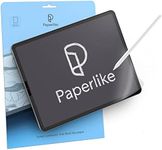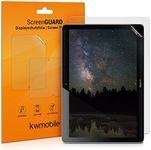Buying Guide for the Best Ipad Screen Protectors
Choosing the right iPad screen protector is important to keep your device safe from scratches, smudges, and even cracks. With so many options available, it’s helpful to understand the key features that make a screen protector suitable for your needs. Think about how you use your iPad—whether for drawing, reading, gaming, or general use—and let that guide your decision. The right screen protector should enhance your experience, not get in the way.MaterialThe material of a screen protector determines its durability, feel, and level of protection. The most common materials are tempered glass and plastic (PET or TPU). Tempered glass protectors are thicker, offer better protection against drops, and feel more like the original screen, making them great for general use and those who want a premium feel. Plastic protectors are thinner, lighter, and more flexible, which can be better for those who want minimal bulk or use a stylus for drawing. If you’re rough on your device or want the best protection, go for tempered glass. If you prefer a lighter touch or use your iPad for art, a high-quality plastic protector might be best.
Finish (Matte vs. Glossy)The finish of a screen protector affects how it looks and feels. Matte protectors reduce glare and fingerprints, making them ideal for reading, outdoor use, or drawing, as they mimic the feel of paper. Glossy protectors keep the screen looking vibrant and clear, which is great for watching videos or viewing photos. If you often use your iPad in bright environments or want a paper-like feel for writing, choose matte. If you prioritize screen clarity and color, glossy is the way to go.
ThicknessThickness impacts both protection and touch sensitivity. Thicker protectors (usually found in tempered glass) offer more protection against drops and scratches but can slightly affect touch sensitivity. Thinner protectors (often plastic) maintain the original touch experience but may not protect as well from impacts. If you’re worried about drops, a thicker protector is safer. If you want the screen to feel as close to the original as possible, a thinner option is better.
Touch SensitivityTouch sensitivity refers to how well the screen responds to your fingers or stylus with the protector on. High-quality protectors maintain excellent touch response, while lower-quality or very thick protectors can make the screen less responsive. If you use your iPad for drawing, note-taking, or gaming, prioritize a protector that advertises high touch sensitivity or is specifically designed for stylus use.
Installation MethodHow easy it is to install the screen protector can make a big difference. Some protectors come with alignment frames or installation kits to help you apply them without bubbles or dust. Others may require more careful manual placement. If you’re not confident in applying screen protectors, look for one with an easy installation system or clear instructions to avoid frustration and ensure a clean result.
CompatibilityNot all screen protectors fit every iPad model, as sizes and shapes vary. It’s important to choose a protector that matches your specific iPad version, including the model and screen size. Double-check your iPad’s model number and make sure the protector is designed for it to ensure proper fit and full coverage.








![SPARIN Screen Protector, [2 Pack] A](https://images-proxy.bestreviews.guide/nlvC7ohfhqC6jCuCDdyAZJ66Jew=/0x150/https://m.media-amazon.com/images/I/51m75LaEqxL._AC_CX679_.jpg)










